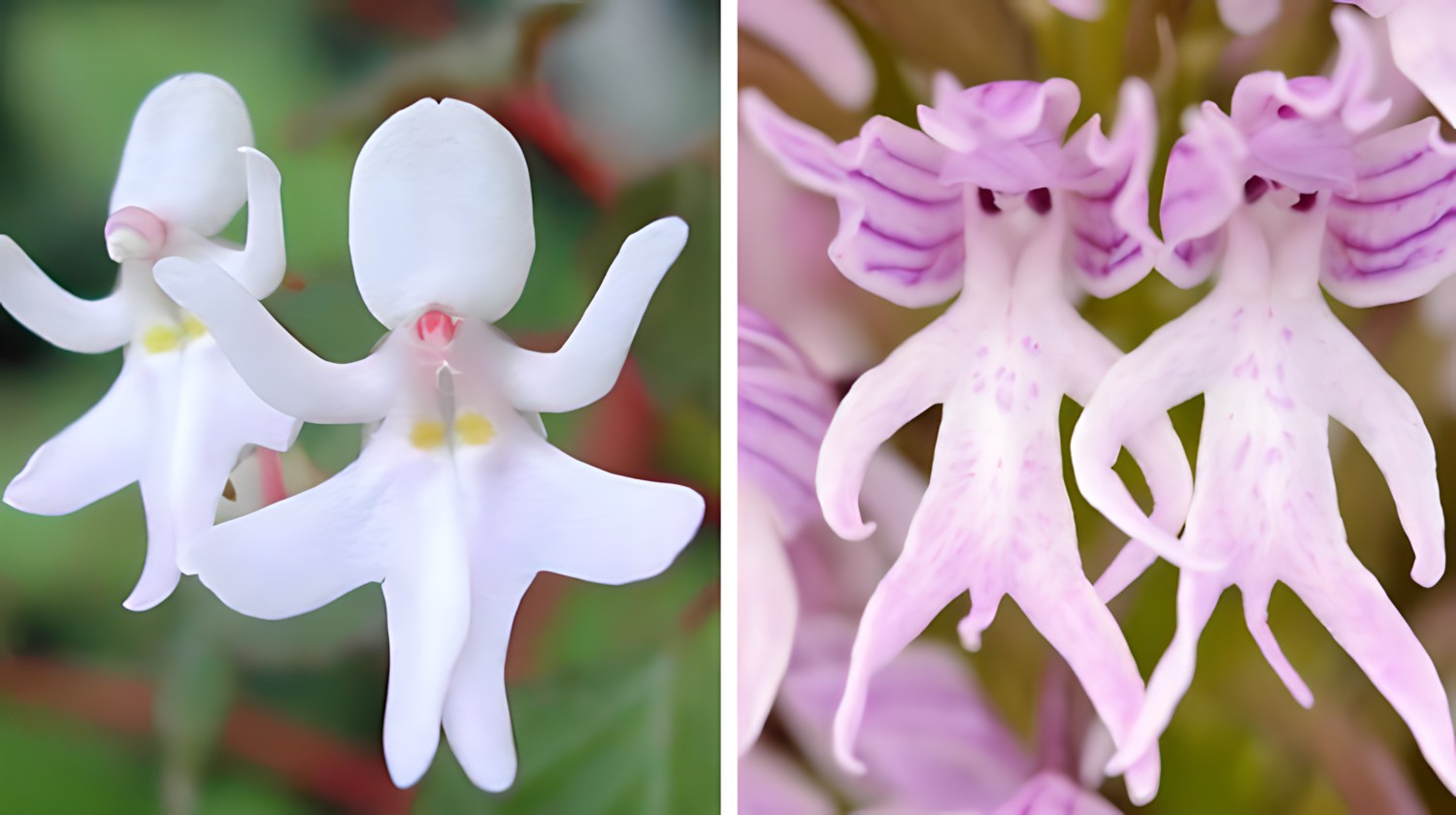While many flowers captivate us with their traditional aesthetic appeal, some go beyond the ordinary, resembling entirely different objects or beings. Whether it’s the form of a peaceful dove, an animated dancer, or even a naked man, the plant world is replete with species that are optical illusions unto themselves. In this article, we explore some of the most astonishingly unique flowers that masquerade as something—or someone—else.
The Orchid Resembling a Nude Man (Orchzis Italica)


Popularly referred to as the Hanging Man Orchid, this Mediterranean species astonishingly mimics the form of a small, naked man down to the finest detail. Available in an array of sizes—as one would naturally expect with male figures—and in shades ranging from soft purplish-white to rich purplish-pink, this orchid is currently endangered. It is speculated that its decline could be linked to its medicinal uses, which include acting as an antidiarrheal, antiflatulent, and even an aphrodisiac. Interestingly, these vivid flowers are used to make Salep, a critical component in the culinary delight known as Turkish Delight.
The Dancing Girls (Impatiens bequaertii)

Locating this elusive flower could be a challenge even for the most committed plant collector. With a remarkable likeness to women dancing in flowing gowns, this species ranks among the rarest flowers. The plant itself is quite petite, spanning about a foot in diameter, with blooms that can extend up to a foot in length. Native to East Africa, it is available in hues of white and soft pink. Remarkably, the plant roots wherever it comes into contact with soil, making it an excellent candidate for indoor horticulture.
Weber’s Living Stones (Lithops comptonii)

A flowering rock, you ask? Indeed, that is the case with Lithops Weberi, colloquially known as Living Stones. These are perfect for indoor cultivation, especially for those who do not possess the proverbial green thumb. Endemic to South Africa, they have evolved to become drought-resistant. When in bloom, the plant presents an unusual sight—a white or yellow daisy emerging from what looks like a solid rock. If you wish to propagate more Living Stones, simply pluck a leaf and place it in a pebble bed; the plant will take root in due course.
Flying Duck Orchid (Caleana major)

What gives this orchid its extraordinary duck-like appearance? It turns out that the shape facilitates the flower’s pollination. The scent draws sawflies, which land on the “bill.” Their weight triggers a mechanism that curls the “bill” downwards, driving the insect into the flower. The only way out for the insect is through a pollen-laden part of the flower, ensuring effective pollination. Despite its shape, the orchid is hard to spot due to its brownish-red color, which camouflages it within the Australian landscape. Unfortunately, if you had dreams of cultivating this orchid, you would be disappointed to learn that it only exists in the wild in Australia and has never been successfully cultivated. It relies symbiotically on a specific type of fungus that is exclusive to Australia.
Pinwheel of Protea (Leucospermum catherinae)

Also known as the Catherine-wheel, this bloom belongs to the “firework pincushion” family of flowers. Indeed, it bears a striking resemblance to a spinning firework. As it matures, the flower heads become disc-shaped, featuring pale orange flowers approximately 6 inches in diameter. From the center of each flower emerges a long, initially orange and then coppery bronze style, crowned by a thickened magenta tip. This gives the entire flower head the look of a rotating pincushion, or alternatively, a Catherine’s wheel. The plant can thrive both indoors and outdoors, provided it has sufficient air circulation, sunlight, and drainage. However, it’s important to note that this species is endangered in its natural habitat due to its limited range.
Burning Lips (Psychotria elata)

What might seem like bright red lips are actually bracts, not petals, and are colloquially known as Flower Lips. These bracts last only a few days in their ‘kissable’ form before they open up to unveil small yellow and white flowers. Native to the tropical regions of Columbia, Costa Rica, and Panama, this plant is endangered due to its popularity among collectors and the degradation of its natural habitat. It remains to be seen whether this botanical jewel will survive the test of time.
Swaddled Babies (Anguloa uniflora)

Discovered during a ten-year expedition in the Colombian Andes between 1777 and 1788, but only formally classified in 1798, this flower’s unique shape mimics that of a newborn wrapped in white swaddling clothes at certain stages of its blooming period. The flower’s hinged petal emits a fragrance that draws insects into its column. Once there, the insects are showered with pollen, enhancing the plant’s chances of pollination. This orchid can also be cultivated at home, making it a dual wonder of both nature and horticulture.
Bee Orchid (Ophrys apifera)

Named for its remarkable resemblance to a bumblebee, the Bee Orchid is increasingly becoming rare due to its complex propagation process. It is native to regions extending from Europe to the Middle East and even North Africa. To flourish, the plant necessitates a symbiotic relationship with a specific type of fungus, rendering transplantation exceedingly challenging. Interestingly, the flower employs cunning tactics: it not only mimics the appearance but also the scent of a female bee, thereby attracting male bees to facilitate faster pollination.
Dove Orchid or Holy Ghost Orchid (Peristeria elata)

This orchid is native to Panama and serves as the country’s national flower. It features finely marbled white blossoms that contain a miniature dove with open wings at their center. Unlike many orchids that grow on or near trees, this one is terrestrial, often growing on rocks. The intricate dove inside the flower is so detailed it looks as if it’s been sculpted from ivory. Its alternative name, the Holy Ghost Orchid, stems from the Biblical depiction of the Holy Ghost as a dove. Due to over-collection, this orchid is now endangered in its native habitat.
Brazilian Dutchman’s Pipe (Aristolochia gigantea)

This peculiar flower, native to Brazil, bears resemblance not just to a pelican but also to a Sherlock-style pipe popular in the Netherlands. Despite its eye-catching beauty, the flower emits a foul odor. Adding to its strange nature, the Pipevine Swallowtail butterfly is often confused by the plant, mistaking it for its native host. Unfortunately, the Dutchman’s Pipe does not provide nourishment for the butterfly’s eggs and instead ends up killing the caterpillars.
Monkey Orchid (Dracula simia)

Belonging to the Dracula genus of orchids—commonly known as “Monkey Orchids”—this family comprises over 110 different species that bear an uncanny resemblance to monkey faces. Most of these orchids are found at elevations exceeding 3,000 feet in the mountainous rainforests of southern Ecuador and Peru. This unique plant blooms year-round and features flowers that emit a fragrance similar to ripe oranges.
Parrot Flower (Impatiens psittacina)

If you’ve never seen a Parrot Flower, it’s not a coincidence. Native to Thailand, this flower is restricted from export due to its endangered status. When viewed from the side, the flower astonishingly looks like a flying parrot. Initially, when photographs of this flower surfaced online, many dismissed them as manipulated images. However, this is far from the truth; they are genuinely that rare and intriguing.
Snapdragon Seed Pod (Antirrhinum majus)

The term “snapdragon” originates from the flower’s unique mechanism that causes its “mouth” to open when its neck is squeezed, resembling a dragon’s jaw. Once the flower turns to seed, it produces what are often referred to as “dragon skulls,” another less-known but fascinating aspect of this plant. Historically, Snapdragons were believed to possess magical properties, protecting households from curses and evil spirits.
Tiger-Faced Moon Orchid (Phalaenopsis amabilis)

One of Indonesia’s national flowers, the Moon Orchid boasts stripes almost identical to those on a tiger, raising questions about what kinds of creatures this stunning flower is trying to deter.
Chamber Maids (Calceolaria uniflora)

Also known as Darwin’s Slipper or the Happy Alien, these unique mountain flowers are quite a sight. First discovered by Darwin during his voyages between 1831 and 1836, these flowers are still abundant in Tierra del Fuego, South America. Local birds are attracted to the flower’s small white “plate,” helping in its pollination process.
Angel Orchid (Zygopetalum rhein)

First discovered in 1932, this orchid remarkably resembles an angel dressed in a gown and is native to the grasslands of India. The plant itself is quite petite, featuring a heart-shaped leaf that lies flat on the ground.
Fly Orchid (Ophrys insectifera)

This European orchid species mimics the appearance of small flies, complete with large, black, bug-like eyes. However, its name actually refers to its ability to attract flies and aphids for pollination purposes.
White Egret Orchid (Pecteilis radiata)

This orchid is named after the bird it resembles when in full flight. Native to Asia, but also thriving in the U.S., this orchid is a favorite among both collectors and gardeners.
Virgin Mary Moon Orchid (Phalaenopsis amabilis)

This orchid appears to be a regular Moth Orchid but on closer inspection reveals a miniature sculpture of the Catholic Madonna within its petals.
Devil’s Hand (Chiranthodendron pentadactylon)

Also known as the Monkey’s Hand or Monkey Paw, this orchid is native to Mexico. The fruit of this tree has been used in traditional medicine for treating heart conditions.
Lobster Claw (Heliconia rostrata)

This vibrant flower, also known as the False Bird of Paradise and Wild Plantain, has bright blooms that grow from bunches of banana-like leaves. The actual flowers are hidden by the red, claw-like bracts and require specialized bird beaks for pollination.
Do you know of any other plants that seem to belong in another realm? We’d love to hear your thoughts in the comments!






